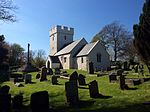Royal Air Force Rhoose, or more simply RAF Rhoose, is a former Royal Air Force satellite station located near Rhoose, 10 miles (16 km) south west of Cardiff and 2 miles (3 km) east of RAF St Athan, Vale of Glamorgan, Wales. It was first used by an Operational Training Unit in April 1942, as additional space, until May 1943. The airfield then remained unused until February 1944, when an Air Gunnery School operated out of RAF Rhoose until August 1944. It was then placed into care and maintenance until transferred to RAF Maintenance Command in November 1944. After the Second World War, the airfield became a sub-site of a Maintenance Unit. The MU and airfield closed in 1948.The new airfield at Rhoose was urgently needed to relieve RAF Llandow. The latter opened as an Aircraft Storage Unit (A.S.U.) but was then allocated a training unit on top. There were a number of reasons, there was a need for space to accommodate operational squadrons in the south-east of England, and a need to move the training schools and trainee pilots away from any Luftwaffe incursions.RAF Rhoose was used immediately upon opening, by the training unit, alleviating RAF Llandow. However, as there were little facilities available at the satellite, all aircraft maintenance had to be done at the parent base.By the end of 1944 the airfield was utilised for aircraft storage, but with hangar space being limited, most of the aircraft were stored in the open, covered with tarpaulin, and the airfield continued in this role until the end of the Second World War. For a short period in 1946, Rhoose was used as a bomb storage depot. However, this was kept as a secret from the local community for fear of complaints and creating panic.











